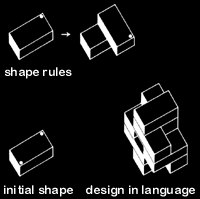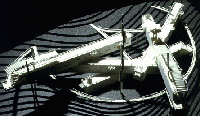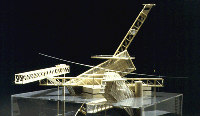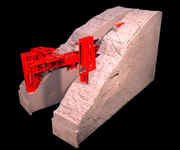With
Knight’s programme, the development of a shape grammar begins with a vocabulary of
shapes and spatial relations between shapes. Spatial relations constrain the ways that
vocabulary elements may be combined with one another. They are simple compositional ideas
and are the key to shape grammars. They provide contexts for adding and subtracting shapes
to create designs. In theory, shapes and spatial relations can be anything at all and are
limitless in number. In practice, the constraints of a design problem (site, economic or
functional requirements, for example) and the constraints the designer brings to the
problem (style or design philosophy, for example) motivate the selection of particular
shapes and spatial relations. Thus, the shapes and spatial relations used to compute
designs often have implicit meanings and functions in the same way that, in a conventional
design process, the lines a designer puts down on paper have meanings.
Spatial relations are explored through additive and subtractive shape rules. Additive
rules are used to define simple shape grammars, called basic grammars. Basic grammars
generate all of the simplest designs possible with one or more given spatial relations.
They are defined by marking or labeling additive rules in different ways according to
symmetry properties of the shapes in the rules. The basic grammars so defined apply
recursively to generate different designs by instantiating the same spatial relations
under different spatial transformations as directed by labels.
An example of the development of basic grammars and designs is shown to the
right. A vocabulary of pillars and a spatial relation between two pillars is defined.
Additive and subtractive rules that add and subtract pillars in accordance with the
spatial relation are given. The pillar added in additive rule is labeled in sixteen
different ways according to the sixteen operations in the symmetry group of the pillar.
Each different labeling defines a different basic grammar and design.
In classroom teaching, basic grammars are presented in a linear,
stage-by-stage way. In design projects, though, students develop grammars in nonlinear
ways that correspond to traditional studio design processes. Shapes, spatial relations,
and rules are continually modified and redefined until the designs generated satisfy the
general goals of a project. These designs are then fine-tuned by detailing basic grammars
to produce more complex grammars, or by using traditional studio methods. Below are three
design projects developed with basic grammars. Simple spatial relations between
three-dimensional shapes are the basis for these projects. |

vocabulary
|
spatial relation
|

additive rule

subtractive rule
 
additive rule labeled in 16 different ways
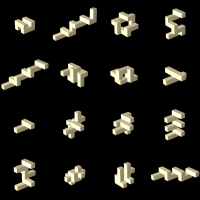
development of basic grammars and designs |
 |
 |
 |
|
|
 illustrates
shape grammars for original languages of paintings. The published theses of Gips and Stiny
both from 1975
illustrates
shape grammars for original languages of paintings. The published theses of Gips and Stiny
both from 1975  , and the joint
Stiny and Gips book Algorithmic Aesthetics from 1978
, and the joint
Stiny and Gips book Algorithmic Aesthetics from 1978  , also illustrate the shape grammar formalism with original grammars for
paintings. The shape grammars in these works are embedded in aesthetic systems for
interpreting and evaluating works of art.
, also illustrate the shape grammar formalism with original grammars for
paintings. The shape grammars in these works are embedded in aesthetic systems for
interpreting and evaluating works of art. 
